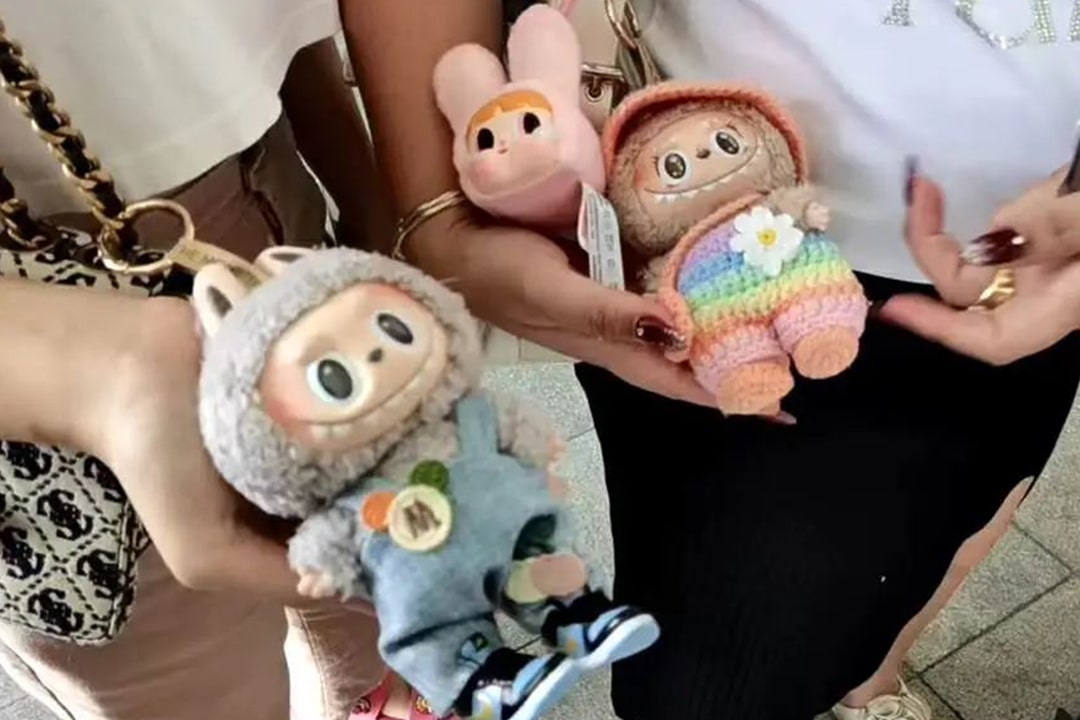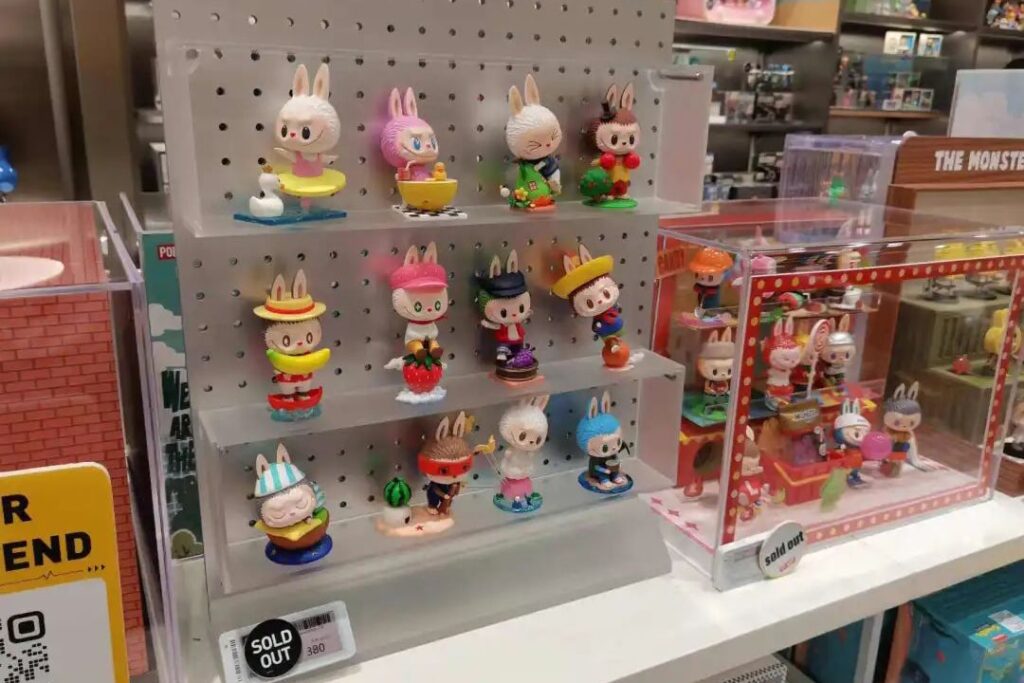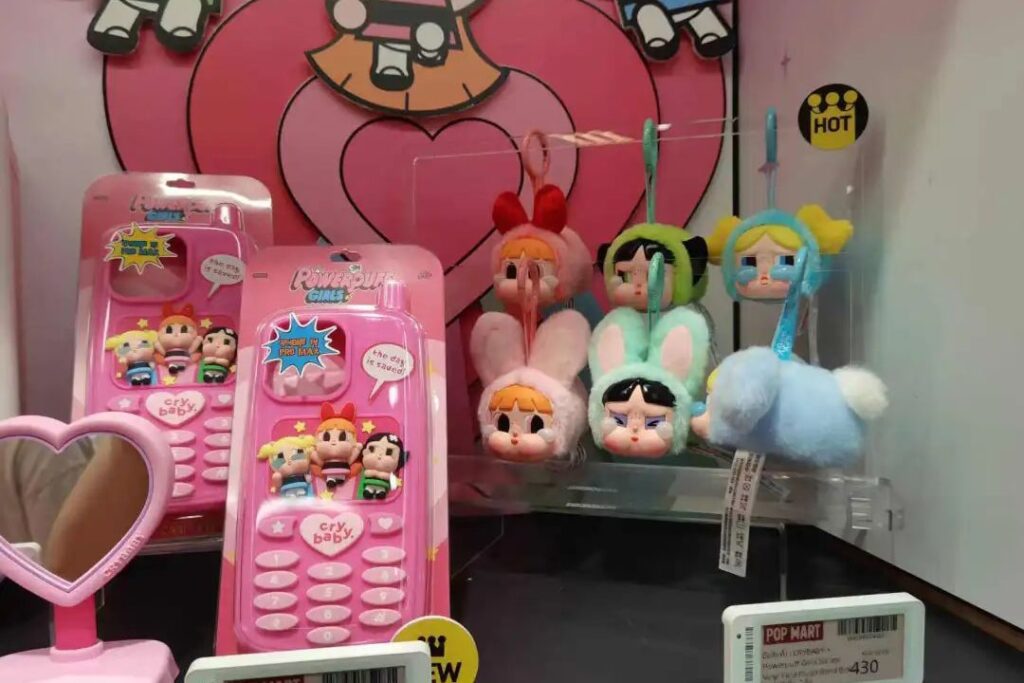
In just months, Labubu’s Thai fan base has made Pop Mart’s biggest overseas success story.
Labubu’s surge in popularity in Thailand has taken even its Chinese fans by surprise.
Across Bangkok, this plush “little monster” is everywhere. People of all ages dangle Labubu keychains from their bags, proudly showing off the brand. An online search in Thai reveals just how pervasive Labubu has become, with posts and promotions from influencers, media outlets, and Pop Mart fans sharing their enthusiasm.
According to a May report by Nielsen, Thailand led the world in TikTok mentions of Labubu and Pop Mart, with over 365,000 comments—dwarfing engagement in other countries, where comments only numbered in the thousands.
This buzz has brought official recognition.
In July, the Tourism Authority of Thailand named Labubu an “Amazing Thailand Experience Explorer,” a role crafted to engage travelers and locals alike. Shortly afterward, Pop Mart launched the world’s first Labubu-themed store at Mega Bangna, Southeast Asia’s largest shopping center. The store set a new record for Pop Mart’s international locations, earning more than RMB 10 million (USD 1.4 million) on its opening day.
Kwan, the store’s manager, has witnessed the Labubu craze firsthand, especially with local customers. One memory stands out: a 74-year-old woman who visited the store with her caregiver.
“She listened to us talk about the stories behind each Pop Mart character, and on her first visit, she bought four full collections. A week later, she returned to buy even more as gifts for her company’s annual event,” Kwan said.
There’s no question: Thailand—and, more broadly, Southeast Asia—has become Pop Mart’s most successful overseas market.
In the first half of 2024, Pop Mart’s international sales climbed to RMB 1.35 billion (USD 189 million), a 259.6% year-on-year increase, making up nearly 30% of the company’s total revenue. Southeast Asia accounted for RMB 560 million (USD 78.4 million), representing over 40% of those international sales.
What’s fueling this rise? And can the Labubu phenomenon be replicated in other regions?
Star power and timing
Labubu, described as mischievous yet kindhearted, is part of Pop Mart’s “The Monsters” collection, created by artist Lung Kasing.
While Labubu had already gained traction in Thailand following the September 2023 launch of Pop Mart’s first Thai store at CentralWorld, the craze took off in April 2024, thanks to Thai-born Blackpink member Lisa. When Lisa shared her Labubu “Macarons” series on Instagram—a gift from a friend—it instantly became the accessory of choice for her fans. Soon, Labubu figures were everywhere, appearing on Lisa’s bags and quickly becoming a favorite.
This celebrity endorsement unleashed a frenzy, sparking demand that spread from Bangkok to other Southeast Asian cities, and the resale market exploded as a result.
According to 36Kr, a standard Labubu “Sitting Party” figure, originally priced at RMB 99 (USD 13.9), now resells for RMB 349 (USD 48.9). In Thailand’s unofficial markets, these figures command up to THB 3,000 (USD 88.6).
Labubu’s popularity has also led to shortages in official Pop Mart channels within China as fans and resellers flock to buy up stock. Yangcheng Evening News reported that some people have even developed bots to secure Pop Mart products online, while scalpers camp out overnight at stores to purchase limited releases.
“Pop Mart has strict policies to prevent reselling by employees,” noted Lin Zheng (pseudonym), a frontline Pop Mart staffer. Employees, Lin Zheng explained, are only notified five minutes before a Labubu figure restock and must count the number of waiting customers. “We announce the restock online and in-store, while another team member quickly stocks the shelves. We need about three employees to handle the process.”
Scoring a Labubu figure comes down to luck, Lin Zheng added. “One time, during a Macaron restock, even the delivery guy took a few boxes for himself. And yes, we often see scalpers in the store.”

Luck, timing, and strategy
The Labubu craze hasn’t let up in Thailand. A 36Kr visit to Pop Mart locations in Bangkok revealed that 70% of products were sold out.
Kwan, the store manager, closely tracks store operations and inventory levels, noting that 90% of customers are local Thais. Many of them buy four or more mystery boxes per visit.
In response to this demand, Pop Mart’s Southeast Asia division has streamlined its supply chain. Thai stores are restocked two to three times weekly, with new products launching every Friday through an online reservation system. This approach helps maintain a steady supply across all Thai locations.
By June 2024, Southeast Asia became Pop Mart’s top-performing international region, bringing in RMB 560 million (USD 78.4 million), up 478.3% from last year and accounting for 41.1% of international sales. In comparison, East Asia (including Hong Kong, Macau, and Taiwan) generated RMB 480 million (USD 67.2 million), while North America brought in RMB 180 million (USD 25.2 million).
| Market | Revenue | YoY Revenue Growth | Revenue (% of Overseas Total) |
|---|---|---|---|
| Southeast Asia | RMB 560 million | 478.3% | 41.4% |
| East Asia (including Hong Kong, Macau, and Taiwan) | RMB 480 million | 153.7% | 35.4% |
| North America | RMB 180 million | 377.7% | 13.2% |
| Europe and other markets | RMB 140 million | 158.8% | 10.3% |
Pop Mart’s international business head, Wen Deyi, attributes this success to a combination of timing and strategy.
The timing, Wen explained, came down to Lisa’s endorsement and Thailand’s tourism revival following the pandemic. “Had Pop Mart entered Thailand two or three years earlier, it might not have had the same impact,” he said.
The strategy reflects Pop Mart’s refined approach to global expansion.
After opening its first international store in Seoul, South Korea, in 2018, Pop Mart transitioned from B2B distribution to a direct-to-consumer (D2C) model in 2019. By 2021, it expanded to Singapore, which served as a gateway into Southeast Asia. Pop Mart also tailors its expansion efforts by evaluating market potential through e-commerce sales and social media engagement before setting up physical stores.
Pop Mart maintained its presence at the Thailand Toy Expo (TTE) during the pandemic, establishing connections with top designers, including Thai artist Molly.
The 2021 “Crybaby” collaboration with Molly has since become another fan favorite, boosting awareness of the Pop Mart brand in Thailand ahead of its first brick-and-mortar opening.

The Southeast Asia advantage
Southeast Asia’s demographics offer a distinct edge for collectible brands.
Euromonitor data shows that, in Indonesia, Malaysia, and Thailand, individuals aged 13–44 make up over 40% of the population in each country. And with six of the region’s 11 countries—Singapore, Malaysia, Thailand, Indonesia, the Philippines, and Vietnam—making up 90% of the population, Southeast Asia has a vast market with rising disposable income.
RELATED ARTICLE
Southeast Asia is the next playground for trendy toys, and brands are cashing in
Written by 36Kr English
But Pop Mart isn’t alone.
In late 2023, Chinese brand 52Toys opened its first store in Thailand, later announcing a 100-store expansion by January. Another competitor, Top Toy, a collectible brand under Miniso, opened in Indonesia and quickly partnered with Butterbear for collaborations. Sources indicate that Top Toy is already eyeing a Bangkok location.
With its franchise-based model, Top Toy’s expansion has outpaced Pop Mart’s D2C approach. However, Pop Mart’s early entry, combined with its commitment to original characters, has given it an advantage that will be tough to replicate. Founder Wang Ning recently expressed confidence in building “another Pop Mart” overseas, with the company expecting its international revenue to exceed 40% of total sales by the fourth quarter.
For Pop Mart, the challenge now is sustaining Labubu’s momentum in Southeast Asia—and replicating Thailand’s success in other regions.
An industry insider noted that Labubu’s popularity owes much to Lisa’s endorsement, cautioning that Pop Mart should avoid “blind box fatigue,” which hit the Chinese market in 2022.
In July, Pop Mart opened its 100th international store in Jakarta, with plans for 20 more Southeast Asian locations by year-end and another ten by 2025.
| Date | Milestone |
|---|---|
| September 2020 | Pop Mart opened its first overseas store in Seoul, South Korea. |
| January 2021 | Pop Mart’s first store in Singapore opened in Funan Mall. |
| March 2021 | Pop Mart’s first North American store opened in Vancouver, Canada. |
| January 2022 | Pop Mart opened a store on Shaftesbury Avenue, London, marking its entry into the UK market. |
| June 2022 | Pop Mart opened a store in South Coast Plaza, California, US. |
| September 2022 | Pop Mart opened a store in Place du Chatelet, Paris, France. |
| September 2023 | Pop Mart opened a store in CentralWorld, Thailand, marking its entry into the Thai market. |
| September 2024 | Pop Mart opened a store in Ba Na Hills, Da Nang, Vietnam. |
| July 2024 | Pop Mart opened its first Labubu-themed store in Bangkok, Thailand. |
| July 2024 | Pop Mart opened a store in Jakarta, Indonesia, marking the 100th store in the East Asia region, including Hong Kong, Macau, and Taiwan. |
| July 2024 | Pop Mart opened an official floating store in Paris, France, the first floating store by a Chinese toy brand. |
Wen emphasized that each market requires local adaptation. For instance, in the Philippines, where employees often get paid on the 15th and 30th of each month, Pop Mart adjusts its inventory timing. In Bangkok, notorious for traffic, restocking robot vending machines requires motorbikes and pushcarts.
Balancing standardization with local adjustments will remain key for Pop Mart as it expands—even down to details like store lighting.
Looking ahead, Pop Mart plans to enter new locations, from Thailand’s tourist hubs like Chiang Mai and Pattaya to major cities in Vietnam. Meanwhile, a Vietnam-based production facility is expected to meet 10% of global supply by the end of the year.
Outside Southeast Asia, Pop Mart is also building a footprint in Europe and North America.
With its ambition to be “China’s Disney,” Pop Mart understands the importance of storytelling and the emotional appeal that drives each character.
To fulfill this vision, Pop Mart has ventured into film, gaming, and urban parks. But in well-established markets like the US, Europe, and Japan, Pop Mart faces a long road before it can challenge industry giants like Lego and Bandai.



